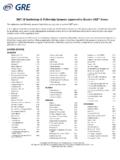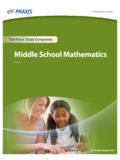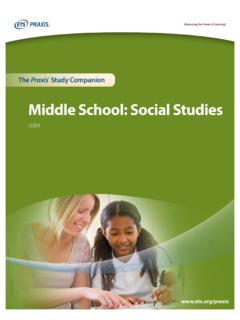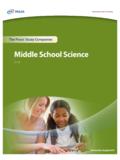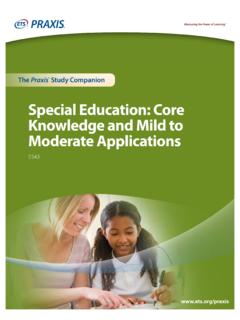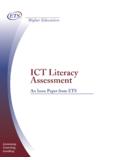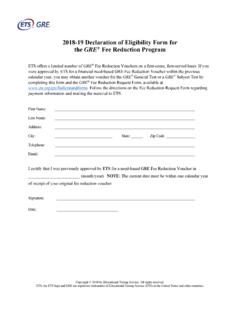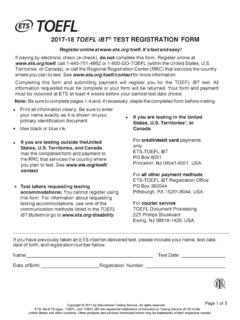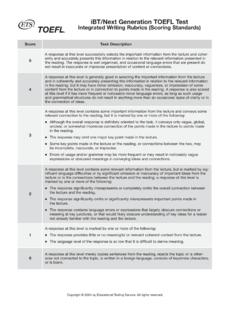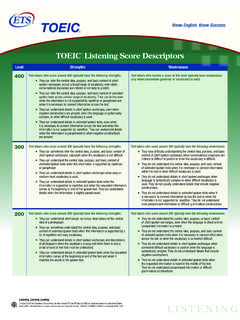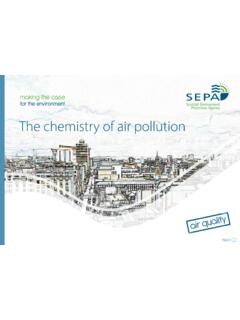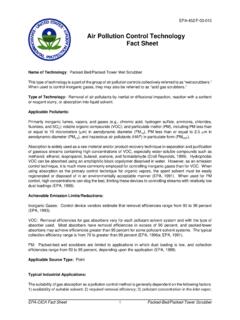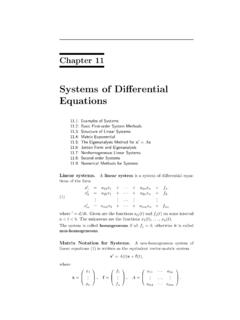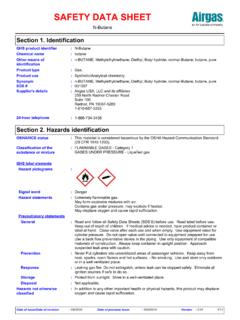Transcription of Middle School Science Study Companion
1 Middle School Science Praxis Study CompanionThe Praxis Study Companion2 Welcome to the Praxis Study CompanionWelcome to The Praxis Study Companion Prepare to Show What You KnowYou have been working to acquire the knowledge and skills you need for your teaching career. Now you are ready to demonstrate your abilities by taking a Praxis test. Using The Praxis Study Companion is a smart way to prepare for the test so you can do your best on test day. This guide can help keep you on track and make the most efficient use of your Study Study Companion contains practical information and helpful tools, including: An overview of the Praxis tests Specific information on the Praxis test you are taking A template Study plan Study topics Practice questions and explanations of correct answers Test-taking tips and strategies Frequently asked questions Links to more detailed informationSo where should you start?
2 Begin by reviewing this guide in its entirety and note those sections that you need to revisit. Then you can create your own personalized Study plan and schedule based on your individual needs and how much time you have before test in mind that Study habits are individual. There are many different ways to successfully prepare for your test. Some people Study better on their own, while others prefer a group dynamic. You may have more energy early in the day, but another test taker may concentrate better in the evening. So use this guide to develop the approach that works best for teaching career begins with preparation. Good luck!Know What to ExpectWhich tests should I take? Each state or agency that uses the Praxis tests sets its own requirements for which test or tests you must take for the teaching area you wish to you register for a test, confirm your state or agency s testing requirements at are the Praxis tests given?
3 Praxis tests are given on computer. Other formats are available for test takers approved for accommodations (see page 41).The Praxis Study Companion3 Welcome to the Praxis Study CompanionWhat should I expect when taking the test on computer?When taking the test on computer, you can expect to be asked to provide proper identification at the test center. Once admitted, you will be given the opportunity to learn how the computer interface works (how to answer questions, how to skip questions, how to go back to questions you skipped, etc.) before the testing time begins. Watch the What to Expect on Test Day video to see what the experience is and when are the Praxis tests offered?You can select the test center that is most convenient for you. The Praxis tests are administered through an international network of test centers, which includes Prometric Testing Centers, some universities, and other locations throughout the schedules may differ, so see the Praxis web site for more detailed test registration information at The Praxis Study Companion4 Table of ContentsTable of ContentsThe Praxis Study Companion guides you through the steps to success1.
4 Learn About Your Test ..5 Learn about the specific test you will be taking2. Familiarize Yourself with Test Questions ..18 Become comfortable with the types of questions you ll find on the Praxis tests3. Practice with Sample Test Questions ..22 Answer practice questions and find explanations for correct answers4. Determine Your Strategy for Success ..32 Set clear goals and deadlines so your test preparation is focused and efficient5. Develop Your Study Plan ..35 Develop a personalized Study plan and schedule6. Review Smart Tips for Success ..39 Follow test-taking tips developed by experts7. Check on Testing Accommodations ..41 See if you qualify for accommodations to take the Praxis test8. Do Your Best on Test Day ..42 Get ready for test day so you will be calm and confident9. Understand Your Scores ..44 Understand how tests are scored and how to interpret your test scoresAppendix: Other Questions You May Have.
5 46 The Praxis Study Companion5 Step 1: Learn About Your Test1. Learn About Your TestLearn about the specific test you will be takingMiddle School Science (5442)Test at a GlanceTest Name Middle School ScienceTest Code 5442 Time 150 minutesNumber of Questions 125 Format Selected-response questionsTest Delivery Computer delivered Approximate Approximate Content Categories Number of Percentage of Questions Examination I. Nature and Impact of Science and 17 14% Engineering II. Physical Science 38 30% III. Life Science 38 30% IV. Earth and Space Science 32 26% All questions assess content from the above Science domains. More than 40 percent of questions integrate a Science and Engineering Practice, and approximately 30 percent of questions assess content applied to a Task of Teaching This TestPraxis Middle School Science is designed to measure knowledge and competencies important for safe and effective beginning practice as a teacher of Middle School Science .
6 Test takers have typically completed a bachelor s degree program with appropriate coursework in Science and education. Content topics span the Middle School Science curriculum, including content related to (I) Nature and Impact of Science and Engineering, (II) Physical Science , (III) Life Science , and (IV ) Earth and Space assessment is designed and developed through work with practicing Middle School Science teachers, teacher educators, and higher education content specialists to reflect the Science knowledge teachers need to teach the Middle School Science curriculum and to reflect state and national standards, including the National Science Teaching Association Preparation Standards for Middle School Science . Content and practices measured reflect the Disciplinary Core Ideas (DCIs) and Science and Engineering Practices (SEPs) established by the National Research Council in A Framework for K-12 Science Education and included in the Next Generation Science Standards.
7 The 125 selected-response questions measure concepts, terms, phenomena, methods, applications, data analysis, and problem solving in Science . A full list of the Science topics covered is provided in Content Praxis Study Companion6 Step 1: Learn About Your TestTest takers will not need to use calculators in taking this test. The periodic table of the elements is available as a Help screen, along with a table of information that presents various physical constants and a few conversion factors among SI units. Whenever necessary, additional values of physical constants are included with the text of a takers can expect forty percent or more of the questions on the test to integrate Science content knowledge with one or more of the SEPs, listed under Science and Engineering Practices. Test takers will also find that approximately thirty percent of questions call for application of physical Science content and processes within a teaching scenario or an instructional task.
8 Such questions designed to measure applications of Science knowledge to the kinds of decisions and evaluations a teacher must make during work with students, curriculum, and instruction situate Science content questions in tasks critical for teaching. Below, in Tasks of Teaching Science , is a list of tasks that are a routine part of Science instruction. These tasks, identified based on research on Science instruction, have been confirmed by a national committee of teachers and teacher educators as important for effective teaching of secondary : This test may contain some questions that do not count toward your TopicsThis list details the Science topics that may be included on the test. All test questions will cover one more of these throughout the Study topics are discussion areas, presented as open-ended questions or statements. These discussion areas are intended to help test your knowledge of fundamental concepts and your ability to apply those concepts to situations in the classroom or the real world.
9 Most of the areas require you to combine several pieces of knowledge to formulate an integrated understanding and response. If you spend time on these areas, you will gain increased understanding and facility with the subject matter covered on the test. You may want to discuss these areas and your answers with a teacher or that this Study Companion does NOT provide answers for the discussion area questions, but thinking about the answers to them will help improve your understanding of fundamental concepts and will probably help you answer a broad range of questions on the Nature and Impact of Science and EngineeringA. Nature of Science and Engineering1. Nature of scientific knowledgea. Use of a variety of methodsb. Based on empirical evidencec. Models, laws, and theories explain natural phenomenad. Major concepts developed over time / Subject to revision in light of new evidencee.
10 Crosscutting concepts and processes 2. Engineering Designa. Define problems and identify criteria and constraintsb. Design, test, and evaluate possible solutions with respect to how well they meet the criteria and constraintsc. Optimize the design solution through a systematic process of modification and testing3. Safety, Materials, and Standard Equipment in the Laboratory and Fielda. Understands safety and emergency procedures in the laboratory and field Equipment ( , eyewash stations, safety showers) Appropriate student apparel and behavior ( , goggles, clothing) Emergency procedures for minor burns and other injuries Emergency procedures for mishaps ( , fires, chemical spills) Awareness of potential hazards ( , allergies, asthma, environmental hazards)b. Is familiar with the procedures for safe and correct preparation, storage, use, and disposal of materials in the laboratory and field Safe storage Proper use and safe disposal ( , chemicals, biohazards, sharps) Proper selection and preparation Use of equipment ( , fume hoods, safety goggles, waste containers)The Praxis Study Companion7 Step 1: Learn About Your Testc.
